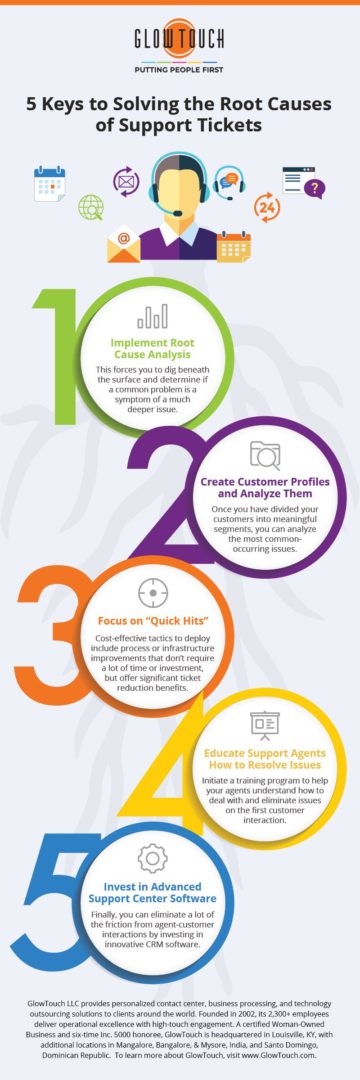Root cause analysis in customer service can reduce the number of tickets received by the customer service teams.
Root cause analysis is an effective method for identifying the underlying causes of problems and finding solutions to prevent them from recurring in the future. By analyzing the root causes of common issues, call center managers can implement targeted solutions that address the underlying problems and prevent customers from experiencing the same issues again.
This not only improves customer satisfaction, but also reduces the number of tickets received by the customer service team. Fewer tickets enable the team to focus on more complex customer issues.
Root cause analysis is an effective tool for streamlining call center operations and improving customer service.
Any operations manager in a customer support center will say that support tickets are one of the biggest cost variables that a company must face, in terms of both volume and duration. In North America, the average cost per ticket comes to $15.56, and can even go as high as $49.69!
A high volume of tickets generally indicates that at the heart of the matter, your customers are facing unresolved problems. Customer support issues not resolved on first interaction have a direct correlation to lower customer satisfaction results. In addition to more tickets, dissatisfied customers may even share their frustrations with friends, or air their grievances over social media.
The bottom line is, it’s important to eliminate the root causes of support tickets in order to save on costs and increase customer satisfaction. Of course, in order to eliminate those root causes you must first identify them, and then address them in the most effective way possible. The following information will discuss 5 key steps that can help.
1. Implement root cause analysis in your call center
Obviously, before you can solve the issues at the core of your support ticket problems, you must first clearly identify them. In order to accomplish this, you must engage in some form of “root cause analysis” (RCA for short) — in other words, a systematic process for identifying the root causes of increased ticket volume or resolution time.
Fortunately, root cause analysis doesn’t have to be a complicated process. As a starting point for your investigation, you can follow a simple 5-step approach focused around asking “Why?” The steps are as follows:
- Describe what took place (the nature of the ticket, the customer issue, roadblocks to resolution, etc.)
- Ask “Why?”
- Listen to the answer given
- Ask “Why?” again
- Repeat steps 2 through 4 until the root cause has been identified
Root cause analysis is an important first step because it forces you to dig beneath the surface and determine if a common problem is actually a mere symptom of a much deeper issue.
2. Analyze support tickets to create customer profiles their common needs
Another step that will help you to narrow down your focus is the compilation and analysis of customer profiles. Think of it this way: if your support team is flooded with technical support requests from older people, day in and day out, then you should analyze common problems that older users experience and prioritize the reduction of those issues, instead of challenges that younger users may face.
How can you successfully create customer profiles to assist your efforts? There are several routes you can take, such as:
- Categorizing your customers by specific characteristics (age, location, gender, education, etc.)
- Categorizing customers by the product they use
- Dividing customers into two primary groups: the ones that are likely to have their ticket resolved the first time, and those that are not
Once you have divided your customers into meaningful segments, you’ll be able to analyze the most commonly occurring issues that your agents are dealing with and have a better understanding of which customer needs to prioritize for first-call resolution.
3. Implement process or technology improvements to resolve issues that create high volume tickets
After you’ve performed your root cause analysis and segmented your customers, one of the simplest and most cost-effective tactics you can deploy is to focus your remedial efforts on “quick hits” — that is, process or infrastructure improvements that don’t require a lot of time or investment, but offer significant ticket reduction benefits.
As just one example, suppose that a large percentage of customers call in to the help desk for assistance in resetting their password. If that is the case, could you set up a website or a page dedicated to automated password resets? Such a page likely would not require a huge expenditure of resources but would greatly reduce the number of inbound support calls to your center.
4. Educate support agents on how to resolve customer service tickets on first contact
Ultimately, the people who work for your company are your most important resource. Once you’ve clearly identified some root problems that lead to repeat calls or unnecessary time-consuming support tickets, you should initiate a training program to help your agents understand how to deal with and eliminate the source of an issue on the first interaction with a customer.
Several years ago, a company called Bell Canada met this challenge. Business leaders took information around “event clusters,” and trained representatives to not only resolve the caller’s primary concern, but also to anticipate and address “downstream issues.” For instance, customers that would order a particular product or feature would often call back to ask usage-related questions. By providing a quick tutorial to that subset of customers before disconnecting the call, agents were able to reduce “calls per event” by 16%, and customer churn by 6%.
5. Invest in customer service data collection and analysis
A solid technology stack is important to delivering high-quality customer service. You can eliminate a lot of the friction from agent-customer interactions by using a good suite of customer service tools:
Customer Relationship Management Software (CRM)
A good CRM software is essential if you want to improve customer service. With a CRM, you can better manage customer interactions, gain insights into customer behavior, and create more personalized experiences.
In the call center, the CRM software streamlines communication, reduces response times, and increases customer satisfaction. It tracks customer interactions across various channels such as voice and chat. You can use that data for root cause analysis of support tickets. You can also use the data to provide a personalized customer service.
Ticket Management System
A ticket management system in a call center can greatly benefit both the organization and its customers. Some CRM software have a built-in feature for managing support tickets. But most leading CRM tools like Salesforce and HubSpot have a separate ticket management or help desk tool for customer service.
By implementing a ticketing system, call center agents can efficiently track and manage customer queries, ensuring that each customer issue is addressed and resolved in a timely manner. This improves customer satisfaction and helps to maintain a positive brand image.
The help desk system supports customer support ticket analysis by collecting data from support tickets. It enables the root cause analysis in a call center.
AI tools for call center agents
AI driven agent tools in call centers have revolutionized the way customer service representatives handle client interactions. These cutting-edge technologies enable agents to provide prompt, efficient, and personalized service, which translates to higher customer satisfaction rates.
Our AI-powered chat assistant, WizDom, works a s a virtual coach for our call center agents. WizDom serves as a virtual SME, providing every customer service agent with an individual coach, empowering team members to provide fast, accurate service. Not only do agents get the intangible benefit of boosted confidence, but the virtual coach has also proven to contribute to better CSAT and NPS scores.
AI-driven tools like WizDom assist agents in deciphering complex customer queries, reducing the time and effort involved in resolving issues. These tools also facilitate the automation of repetitive tasks, freeing up agents to focus on more pressing matters.
Furthermore, by analyzing customer data, AI-driven tools can provide insights that enable businesses to improve their products and services.
Partner with the Customer Support Experts
The above 5 steps will help you to successfully identify and then resolve the root causes that contribute to an excessive amount of support tickets. Of course, you may need some assistance as you begin to implement these suggestions. Our team of experienced customer support experts at GlowTouch would be happy to help you dig through the details of optimized first-call resolution. Reach out to us today to schedule a free consultation.
Infographic
The following infographic presents 5 key steps you can take to solve the root causes of support tickets.



















































